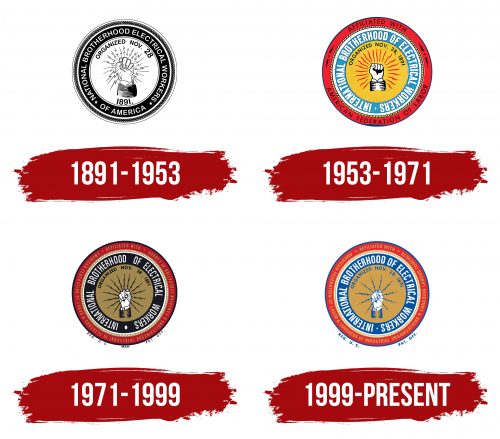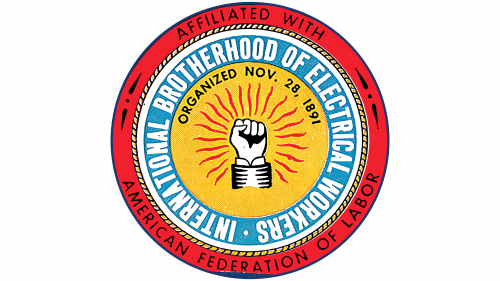The IBEW logo reflects the union’s connection with the electrical industry. It symbolizes energy, strength, and technological development while emphasizing the professional nature of the organization. The emblem suggests that electricity is in safe hands.
IBEW: Brand overview
Meaning and History
The origins of the modern IBEW logo date back to 1891. That’s when the original seal of the union was created and used for marketing purposes. The organization faced financial issues, so it generated income by selling badges with emblems to its new members. The original design was conceived by C. J. Sutter from Minnesota. On November 28, 1891, he proposed using an image of an upraised fist clutching 22 lightning bolts as the seal. It was a left hand, placed within a ring with the inscription “NATIONAL BROTHERHOOD ELECTRICAL WORKERS OF AMERICA” – a reference to IBEW’s first name.
In 1910, the logo was officially recognized by the Union Label and Service Trades Department, AFL-CIO. In 1924, it was also recognized by another regulatory body: the U.S. Patent and Trademark Office. As a result, the union gained the right to depict its seal in the press. In 1973, the organization was permitted to use it in all materials fully. At that time, the left hand was replaced with the right hand. The exact reason for this change is unknown. An unofficial version suggests that the raised left fist became associated with the communist regime, so to avoid negative symbolism, a right fist appeared on the IBEW emblem in 1971.
Before this, the logo had also frequently changed: in 1908, one lightning bolt was removed, and by 1916, there were only 16 left. In 1953, the original number of lightning bolts proposed by C. J. Sutter was restored. In 1971, there were 15, and in 1999, 10. Now, they represent the union’s founders who gathered at the first convention: James Dorsey, Joseph Berlovitz, C. J. Sutter, William Hedden, J. T. Kelly, Henry Miller, Harry Fisher, E.C. Hartung, F. J. Heizlenan, and T. J. Finnell.
What is IBEW?
IBEW stands for International Brotherhood of Electrical Workers. This international organization protects the rights of workers in the electrical industry, provides support in labor matters, and offers opportunities for professional growth. It was founded in 1981 in the USA and has since become one of the most influential unions associated with electrical installation. As of 2023, Kenneth W. Cooper serves as its president.
1891 – 1953
C. J. Sutter created the original logo of IBEW. It depicted a raised left hand clenching 22 zigzag lightning bolts. Above it was the inscription “ORGANIZED NOV. 28,” and below it – “1891.” This part of the emblem was placed inside a large white circle, which was set in a black ring with the text “NATIONAL BROTHERHOOD ELECTRICAL WORKERS OF AMERICA.” The outer frame was decorated with a twisted rope pattern.
1953 – 1971
In 1953, a colored version of the seal with 22 red wavy lightning bolts was approved. They surrounded the fist like sun rays and did not touch it. The central circle turned orange and still contained the company’s founding date, but now it was all shifted upwards. The white inscription “INTERNATIONAL BROTHERHOOD OF ELECTRICAL WORKERS” was in a blue ring, and the outer red frame contained the black text “AFFILIATED WITH AMERICAN FEDERATION OF LABOR.”
1971 – 1999
The central circle became dark beige, and the number of lightning bolts was reduced to 15, reverting to a zigzag shape. However, the main change to the logo was the replacement of the left hand with a right hand, so the fist would not be associated with communism. The central ring was repainted in black – making the company’s white name stand out more. The outer part of the emblem acquired a dark burgundy shade. Inside it was the golden inscription “AFFILIATED WITH AMERICAN FEDERATION OF LABOR & CONGRESS OF INDUSTRIAL ORGANIZATIONS & CANADIAN LABOUR CONGRESS.”
1999 – today
The IBEW logo appeared in 1891, but its current form was officially adopted in 1999 under the leadership of J. J. Barry. He decreed that the image should contain ten lightning bolts, each dedicated to one of the creators of the National Brotherhood of Electrical Workers. The lightning bolts are arranged in a circle, like clock hands, and clenched in an upraised fist. This is a right hand in a sleeve, from which a shirt cuff is visible. Figuratively, it represents the hand of Zeus, firmly holding the power of electricity. Although C. J. Sutter is credited with this original design, the emblem of American Electrical Works (1886-1934) looked remarkably similar. Possibly, Sutter drew inspiration from its advertising.
The fist is within a dark-beige circle and placed under an arched inscription “ORGANIZED NOVEMBER 28, 1891” in blue. This circle is, in turn, enclosed in a wide blue ring. It bears the full name of the union: “INTERNATIONAL BROTHERHOOD OF ELECTRICAL WORKERS,” written in large white letters with slightly slanted strokes. The next layer is a pattern styled like a twisted rope. Beyond that is a dark-red ring with gold text “AFFILIATED WITH AMERICAN FEDERATION OF LABOR & CONGRESS OF INDUSTRIAL ORGANIZATIONS & CANADIAN LABOUR CONGRESS.” Outside the seal, there are two more inscriptions: “REG. U. S.” (on the left) and “PAT. OFF.” (on the right).
Font and Colors
The IBEW logo uses several similar fonts. All are semi-bold grotesques with vertically elongated letters. There are minor differences between them, reflected in the thickness of the strokes or the cut ends. Such typography simplifies the display of the seal in various sizes and enhances the clarity of the inscriptions.
The color palette is also diverse. It includes white, blue, dark beige, red, and gold. This combination became official in 1999.










